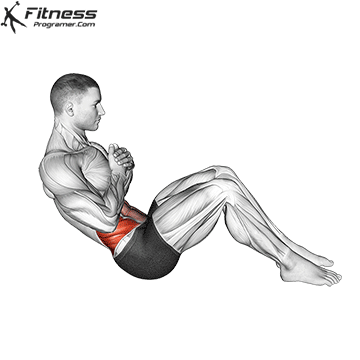Russian Twist
The Russian twist is a popular core exercise that targets the muscles of the abdomen, particularly the obliques. It also engages the lower back and hip muscles to a certain extent. The exercise involves a twisting motion of the torso while sitting on the floor. While the Russian twist can be an effective exercise for strengthening the core and improving rotational stability, it’s important to be aware of potential risks and considerations.
How to do:

- Sit on the floor with your knees bent and your feet flat on the ground.
- Lean back slightly so that your upper body forms a V shape with your thighs. Keep your back straight, and engage your core muscles.
- Clasp your hands together in front of you or hold a weight or medicine ball with both hands. This adds resistance to the exercise.
- Twist your torso to one side, bringing the weight or your hands beside your hip. Keep your core engaged throughout the movement
- Return to the center and then twist to the other side.
- Repeat the twisting motion from side to side for the desired number of repetitions or time.
Balance Challenges:
Lifting the feet off the ground during the exercise challenges balance. While this is beneficial for stability training, individuals with balance issues or concerns should exercise caution and may choose to keep their feet on the ground or use additional support.
Tips:
- It’s important to perform the exercise with control to avoid straining your lower back. If you’re new to this exercise, start with a lower number of repetitions and gradually increase as your core strength improves.
- The Russian twist is a versatile exercise, and you can modify it by adding resistance, using a medicine ball or a weight plate, or changing the angle of your torso for increased difficulty.
Risks of the Russian Twist:
The twisting motion, especially when performed with poor form or excessive momentum, can put strain on the lower back. People with certain medical conditions, such as herniated discs, spinal issues, or recent surgeries, may need to avoid or modify the Russian twist. It’s advisable to consult with a healthcare professional before incorporating this exercise, especially if you have existing health concerns.
Benefits of Russian Twist
- Core Strength:
- The Russian twist primarily targets the muscles of the core, including the rectus abdominis, obliques, and transverse abdominis. It helps to strengthen and tone these muscles, promoting overall core stability.
- Oblique Development:
- The twisting motion of the exercise places a significant emphasis on the oblique muscles, which are responsible for rotation and lateral flexion of the trunk. Strong obliques contribute to a well-defined and functional midsection.
- Improved Rotational Stability:
- The exercise enhances rotational strength and stability, which is beneficial for activities that involve twisting movements, such as certain sports and daily functional tasks.
- Spinal Mobility:
- The rotational aspect of the Russian twist promotes flexibility and mobility in the spine, especially in the thoracic (upper) and lumbar (lower) regions.
- Balance and Coordination:
- Lifting the feet off the ground during the exercise challenges balance and coordination, engaging stabilizing muscles throughout the body. This aspect adds an extra dimension to the workout.
To maximize the benefits and minimize the risk of injury, it’s important to perform the Russian twist with proper form, avoid over-rotation, and adapt the exercise to your fitness level. Individuals with a history of lower back issues should approach this exercise cautiously and may consider modifications or alternative exercises.
Russian Twist: Muscles Worked

